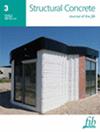Investigation on the flexural behavior of high‐strength fiber‐reinforced concrete
IF 3.3
3区 工程技术
Q2 CONSTRUCTION & BUILDING TECHNOLOGY
引用次数: 0
Abstract
The present research investigated the flexural behavior of high‐strength fiber‐reinforced concrete (HSFRC) with six different types of fiber: hooked‐end and crimped steel fibers, chopped and pultruded glass fibers; monofilament and twisted polymeric fibers. An extensive experimental program with 108 specimens for 3‐point bending tests was carried out and the parameters analyzed were the fiber content (0.50%, 0.75% and 1.00% in volume), the fiber type and the compressive strength of the concrete (60 and 90 MPa). Statistical analyses were performed and showed that regardless of the fiber material, increasing the amount of fibers added to concrete increases residual strength and toughness. Limit of proportionality is not affected by the addition of fibers, while postcracking behavior, on the other hand, is controlled by the fibers. Increasing the compressive strength of the concrete matrix affect mainly the limit proportionality of all mixes and the postcracking behavior of the concrete reinforced with hooked‐end steel fibers. The classification of HSFRC and the conditions required for HSFRC for use in structural applications according to the高强度纤维增强混凝土抗弯行为研究
本研究调查了含有六种不同类型纤维的高强度纤维增强混凝土(HSFRC)的抗弯行为:钩端和卷曲钢纤维、切碎和拉挤玻璃纤维、单丝和扭曲聚合物纤维。实验中对 108 个试样进行了广泛的三点弯曲试验,分析的参数包括纤维含量(体积比为 0.50%、0.75% 和 1.00%)、纤维类型和混凝土抗压强度(60 和 90 兆帕)。统计分析结果表明,无论纤维材料如何,增加混凝土中的纤维添加量都能提高残余强度和韧性。比例极限不受纤维添加量的影响,而开裂后的行为则受纤维的控制。提高混凝土基体的抗压强度主要会影响所有混合料的极限配比和用钩端钢纤维增强的混凝土的开裂后行为。此外,还讨论了 HSFRC 的分类,以及根据纤维模型规范 2010,HSFRC 用于结构应用所需的条件,并验证了这些条件与实验结果不一致,应针对高强度纤维增强混凝土进行修订。
本文章由计算机程序翻译,如有差异,请以英文原文为准。
求助全文
约1分钟内获得全文
求助全文
来源期刊

Structural Concrete
CONSTRUCTION & BUILDING TECHNOLOGY-ENGINEERING, CIVIL
CiteScore
5.60
自引率
15.60%
发文量
284
审稿时长
3 months
期刊介绍:
Structural Concrete, the official journal of the fib, provides conceptual and procedural guidance in the field of concrete construction, and features peer-reviewed papers, keynote research and industry news covering all aspects of the design, construction, performance in service and demolition of concrete structures.
Main topics:
design, construction, performance in service, conservation (assessment, maintenance, strengthening) and demolition of concrete structures
research about the behaviour of concrete structures
development of design methods
fib Model Code
sustainability of concrete structures.
 求助内容:
求助内容: 应助结果提醒方式:
应助结果提醒方式:


